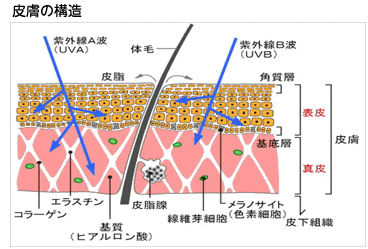You'll find the doctor you're looking for !
JR Saikyo Line, Musashino Line
Musashi Urawa Station / 4-minute walk
Muse Dermatology & Pain Clinic
General Dermatology, Aesthetic Cosmetic/Plastic Surgery Anesthesiology Herbal treatments
Phone:048-866-4112
Fax:048-866-4371
Skincare Products
With Dr.Hitosugi's supervision and the carful selection of high-quality ingredients, we are please to present you our healthy skincare products that is only available at our skincare clinic.
Home > Skincare Products > Learn from Dr.Hitosugi
Our skin covers the surface of our body to protect it from stimulations such as ultraviolet rays. It is also important to adjust to the humidity and temperature. There are generally two layers of the skin called the epidermis and the dermis. The thickness of it can be from 0.4 to 1.5mm.
Epidermis
The upper surface of the skin is called the epidermis, also medically known as “stratum corneum”, where normal skin cells loose their cell nucleus during cornification. In other words, it doesn't consist of any cell nucleus but a collection of dead cells. Since it is covered by sebum secreted from your sebaceous glands, it helps retain moisture and smoothness to the skin and prevents stimulation from the environment. It is made of hard protein cells, making it an overlapped structure with several block-like layers.
The base layer at the bottom of the epidermis have scattered pigment cells called melanocytes, which activates when exposed to ultraviolet light to create a melanin-coloured pigment. As a result, the skin becomes tanned. The entire epidermis layer of the skin takes about 28 days to regenerate for someone in their 20s. The time it takes to regenerate is called “Epidermal turnover time”.

Skin Dermis
Fibroblasts (fiber cells) are made from cells that became a structure which consists of both fibers and matrix. Fibers are mainly made from elastin, collagen, and hyaluronic acid which all play a cushioning role as a reticulated structure by maintaining the skin's elasticity. The substrate is made of a water-soluble collagen and hyaluronic acid between the fibers, where it functions to consistently retain moisture in the dermis.
Summary
Regardless of epidermis layer of the skin is damaged or shocked by external things, the dermis layer of the skin, which mainly consists of collagen, supports the epidermis turnover with moisture and nutrition responsible in maintaining the elasticity of the skin.
◆medically, skin moisture retention drops as we grow older.
| Children - 20s | 100~80% |
|---|---|
| 30s - 40s | 65% |
| 50s | 45% |
| 60s | 25% |
The same thing has happened to the stratum corneum (outer) part of the skin. Since the moisture on the skin’s surface reduces as you get older, it is necessary to compensate for this moisture loss. To provide skincare products which contains a deep moisturizing power, it is possible to clean the basic cosmetics containing a combination of ingredients that gives provides firmness and elasticity to the skin so you can feel your skin shining beautifully and free yourself from your worries of your aging skin.
Aging concerns: What are anti-aging ingredients ?
| Placenta |
(1) Reconstructs the dermal tissue It promotes healthy blood circulation to the skin, the removal of wastes, and increases the functionality of the dermal tissue (2) Improves the clarity of your skin (3) Helps maintain moisture in your skin Natural amino acids helps moisturizes and oils keeps the outer layer of your skin from losing moisture. (4) Supports the firmness of the skin It will help compensate for loss of firmness due to the increase in age. (5) Removal of active oxygen It is an aging care ingredient that provides necessary moisture to aging skin. |
|---|---|
| Hyaluronic acid |
This acid is present in our skin and continues to decrease with age. As a result, moisture is lost, skin becomes drier, and our skin becomes tensionless. It is possible to compensate for this loss by applying it on the outer layer of the skin, which leads to firmer and healthier-looking skin. |
| Squalane | It resides in your skin to protect it and helps activate metabolism. It also helps the shredding of dead skin, protects the skin by its emulsifying properties and helps retains moisture. It also has bacteriostatic effects. |
| glycolic acid | Even among AHA (fruit acids), it contains very fine particles due to the high permeability, which removes dead skin on the outer layer of your skin and helps skin dullness by clarifying the skin. |
| Hydroquinone | It is a popular skincare ingredient for aging skin concerns, which is very similar to arbutin, kojic acid, and vitamin C, and helps support, clarify, and retain the natural beauty of the skin. |
| Nanospheres Q |
(1) Instead of a surfactant, vitamin C derivative and water-soluble vitamin E derivative are formulated together to help capsulate healthy skin and helps familiarize your skin with the vitamin formulations. (2) It helps prevent the declining condition of the skin caused by aging. (3) as a skin conditioning component, and prepares to clean skin. Epidermis were easily pass through, there is work to carry useful ingredient to the dermis. As a skin-conditioning ingredient, It helps condition your skin. It easily penetrates the Epidermis layer of the skin to provide your dermis with nutrition. (4) COQ10 coenzyme Q10 is one of the coenzymes that is present in our body (also known as “ubidecarenone”). It is a necessary ingredient for firmness and retaining elasticity of the skin. It also has a good moisturizing effect that retains moisture usually lost by aging skin and prevents dryness. It’s been a mainstream ingredient among skincare and quite popular. |
▲Return to top of page







